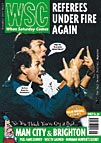 The Premier League conduct an annual survey. John Williams of the Sir Norman Chester Centre for Football Research explains what it's all about
The Premier League conduct an annual survey. John Williams of the Sir Norman Chester Centre for Football Research explains what it's all about
The idea for a national fan survey of Premier League club supporters was hatched around three years ago following discussions between Carling and the FA Premier League itself, primarily its Chief Executive, Rick Parry.
I think basically that Carling wanted to spend some cash on a PR campaign to show their ‘concern’ about fans at Premier League clubs, plus, of course, to find out a little more about the standard audience at the Premier League. This, broadly, seemed okay: if a major sponsor wants to raise its profile by funding research that’s fine, as long as they don't hi-jack the thing as a straightforward piece of self promotion or market research. Ideally, there would be more public funding for work like this, but the funding bodies tend to look at football and argue that there is enough cash already swilling around the game for it to find out, itself, a little more about who watches the game and why.
Of course, Carling hoped the outcome would be positive and that this would reflect glory on the sponsors. But, in truth, much of the 1993-94 survey was about how people came to matches, what they bought, what club facilities they used, as well as covering one or two questions such as experiences of racism, views on clubs’ community activities and so on.
Neither the funders, nor the League, played any real part in constructing the questionnaire or in the presentation of the findings. The first survey was a self-complete questionnaire inserted into match programmes. We got about one quarter returned (just over 10,600), not great, but a start. Carling laid on a glitzy media presentation day, complete with Ray Stubbs and scantily-dressed ‘babes’ handing out cans of the amber fluid and we were, so to speak, off and running.
In 1994-95, CarIing moved into the background and the Premier League itself took on the costs. By this time the League was also running independently-managed supporter panels at each club, so a small number of supporters could discuss in detail things they were concerned about – price, atmosphere, the stadium rebuilds, the relationship between the Premier League and the Football League, etc.
I don’t think this is all guff; I think Parry, especially, is actually quite interested in what supporters are saying about changes in the game. This may not translate into much at club level where chairmen still pretty much do their own thing; but it’s a radical sea change from what's gone on before.
This second survey generated press coverage for its message on the increased numbers of female fans attracted to football. But we also asked if people thought the new League had been a good thing – only around four out of ten did. We covered things like the new marketing of clubs, seats and TV. Again, no interference from the League about the make-up of the questions and the presentation of findings.
We wanted to raise the response rate for the most recent survey, for 1995-96, and to get samples from clubs we could more confidently directly compare with each other. The only real way of doing this given the usual resource constraints was to use their season-ticket databases. (On average, around two thirds of home supporters in the Premier League are now season-ticket holders.) We mailed them directly. The response rate was a very acceptable 44%, over 20,400 total returns. We also got clubs to distribute questionnaires to non-season-ticket holders to make comparisons with the main sample. We had the usual problems there (especially at clubs who, maybe, were not too keen at that time on hearing what their supporters had to say) and a low return.
The main result, however, is the feeling that we can now say a little more about how similar supporters at different kinds of clubs respond to major issues facing the game. In this survey we covered how supporters chose their club; supporter, police and steward behaviour; post-Bosman football in Europe; racism (again); value for money at football; refereeing. You can see some examples here. The main report is yet to be published.
So is this worth doing? Yes, I really think so. Slowly, we are getting a better fix on how the game at the top level and its followers are changing, and from the supporters’ end. This approach is by no means perfect; it probably alienates some working-class supporters and people who don’t like filling in ‘forms’, even about football. At the moment the focus is also too much on season-ticket holders, and it tells us nothing about people who have left the game because of price, seats, etc. Also, the very act of having a national survey like this probably contributes to the view that the Premier League is just different to other football now. (It probably is.) But we have asked the Football League to consider something similar, to help us look at the differences, if any, between crowds at larger and smaller clubs. Nothing doing so far.
Clearly it would be wrong to assume that all Premier League supporters think like the ones in the survey. But, is it not also a mistake simply to assume, as often seems to happen these days, that most supporters are hostile to many of the changes which have occurred in football recently? Supporters may not always be ‘right’; but trying to listen more effectively to what they have to say, well, there has to be something in that, hasn’t there?
From WSC 117 November 1996. What was happening this month